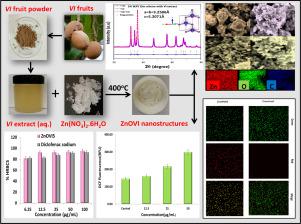Biomaterials Advances ( IF 5.5 ) Pub Date : 2021-01-16 , DOI: 10.1016/j.msec.2021.111887 Josline Neetha D’Souza , Ashwini Prabhu , G.K. Nagaraja , K. Meghana Navada , Sabia Kouser , D.J. Manasa

|
The present study delineates the biosynthesis of ZnOVI nanostructures by using aqueous fruit extract of V. indica. The study has disclosed the role of V. indica fruit extract as both reducing and capping agents, ushering the formation of ZnOVI nanostructures with distinct morphologies. The formation of ZnOVI nanostructures was corroborated by FT-IR and UV–visible spectroscopy which was further substantiated by the elemental composition study through EDS spectroscopy. The nanostructures were also investigated by Rietveld refinement of PXRD data, FE-SEM, and BET analysis. The morphology, size, and surface area were found to be precursor stoichiometry dependent. The in-vitro cytotoxicity study of ZnOVI nanostructures carried out on MDA-MB468 human triple-negative breast cancer (TNBC) cells has revealed their potential cytotoxicity (91.18 ± 1.98). MTT assay performed on the NIH3T3 mouse fibroblast cells has unfolded the non-toxic nature of ZnOVI nanostructures. Additionally, the results of the AO-EB dual staining assay indicated early apoptosis in TNBC cells by displaying greenish yellow-fluorescence in the nuclei. Reactive oxygen species (ROS) measurement study has confirmed the elevated intracellular levels of ROS, supporting the oxidative-stress induced cytotoxicity in ZnOVI nanostructures treated TNBC cells. Furthermore, the haemocompatibility of ZnOVI nanostructures was evaluated using human erythrocytes. Thus, the obtained results have shown greater potential in the anticancer activity of bio-fabricated ZnOVI nanostructures.
中文翻译:

阐明受Vateria indica(L.)水果植物化学物质影响的生物相容性氧化锌纳米结构对人类三阴性乳腺癌的抑制活性
本研究概述了利用V果实的水提物的生物合成ZnOVI纳米结构。该研究揭示了印度V虫的作用水果提取物作为还原剂和加帽剂,促进了具有独特形态的ZnOVI纳米结构的形成。FT-IR和紫外可见光谱证实了ZnOVI纳米结构的形成,而EDS光谱研究的元素组成进一步证实了ZnOVI纳米结构的形成。纳米结构也通过Rietveld精制的PXRD数据,FE-SEM和BET分析进行了研究。发现形态,尺寸和表面积与前体化学计量有关。在MDA-MB468人三阴性乳腺癌(TNBC)细胞上进行的ZnOVI纳米结构的体外细胞毒性研究显示,其潜在的细胞毒性(91.18±1.98)。在NIH3T3小鼠成纤维细胞上进行的MTT分析展现了ZnOVI纳米结构的无毒性质。另外,AO-EB双重染色法的结果表明,通过在细胞核中显示出绿色的黄色荧光,可以使TNBC细胞早期凋亡。活性氧(ROS)测量研究已证实ROS的细胞内水平升高,支持ZnOVI纳米结构处理的TNBC细胞中氧化应激诱导的细胞毒性。此外,使用人红细胞评估了ZnOVI纳米结构的血液相容性。因此,获得的结果显示出在生物制造的ZnOVI纳米结构的抗癌活性方面更大的潜力。在氧化锌诱导的TNBC细胞中支持氧化应激诱导的细胞毒性。此外,使用人红细胞评估了ZnOVI纳米结构的血液相容性。因此,获得的结果显示出在生物制造的ZnOVI纳米结构的抗癌活性方面更大的潜力。在氧化锌诱导的TNBC细胞中支持氧化应激诱导的细胞毒性。此外,使用人红细胞评估了ZnOVI纳米结构的血液相容性。因此,获得的结果显示出在生物制造的ZnOVI纳米结构的抗癌活性方面更大的潜力。











































 京公网安备 11010802027423号
京公网安备 11010802027423号